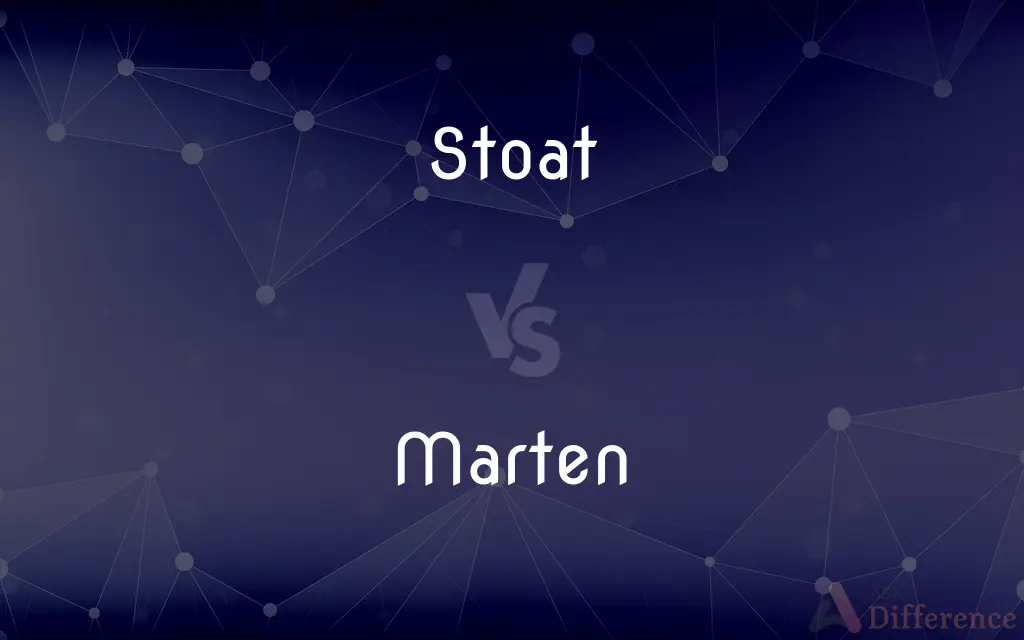Stoat vs. Marten — What's the Difference?
Edited by Tayyaba Rehman — By Fiza Rafique — Updated on April 2, 2024
A stoat is a small, elongated carnivore known for its agility and seasonal white coat, whereas a marten is a larger, tree-dwelling mammal with a luxurious fur and bushy tail.

Difference Between Stoat and Marten
Table of Contents
ADVERTISEMENT
Key Differences
Stoats, also known as ermines in their winter white phase, are characterized by their slender bodies and versatility in habitats, ranging from woodlands to tundras. Martens, on the other hand, prefer forested areas and are recognized for their arboreal lifestyle, often seen climbing trees with ease. While both are members of the Mustelidae family, their physical attributes and environments show clear distinctions.
Stoats are renowned for their dramatic seasonal color change, which provides camouflage against snow, turning their coats from brown to white in winter. Whereas martens maintain their brown fur year-round, with some species sporting distinctive throat patches of varying colors. This fur adaptation in stoats is a survival mechanism in snowy environments, contrasting with the constant coloration of martens that dwell in more stable forested ecosystems.
In terms of size, stoats are generally smaller, with bodies that can be as long as 30 cm (excluding the tail), making them agile hunters of rodents and birds. Martens are larger, with some species reaching lengths of up to 50 cm, allowing them to prey on a wider range of animals, including squirrels and birds. The size difference influences their prey choice and hunting strategies, with stoats being more likely to pursue smaller prey.
Stoats have a unique hunting technique of performing a mesmerizing "dance" that captivates their prey, making it easier to approach and capture. Martens, while also skilled hunters, rely more on their climbing ability to ambush prey from above. This difference in hunting behavior highlights their adaptation to their respective environments and available food sources.
Both animals have valuable fur, but the marten's pelt, especially that of the sable marten, has historically been more sought after for luxury garments. This has led to the marten being more affected by fur trading, whereas the stoat's fur, although used in the past for royal ermine cloaks, is less commonly traded today. The demand for marten fur has influenced conservation efforts and regulations to protect these species from overhunting.
ADVERTISEMENT
Comparison Chart
Size
Smaller, up to 30 cm in body length
Larger, up to 50 cm in body length
Habitat
Versatile, including woodlands and tundras
Prefer forested areas, especially arboreal
Coat Color Change
Yes, from brown to white in winter
No, remains brown year-round
Hunting Technique
Performs a captivating "dance"
Uses climbing ability to ambush prey
Fur Value
Less commonly traded today
Highly valued, especially sable marten fur
Compare with Definitions
Stoat
Stoats can perform a mesmerizing dance to captivate their prey.
The stoat's dance confused the rabbit, making it an easy target.
Marten
Larger than stoats, martens have a more varied diet, including larger prey.
The marten easily captured a squirrel, highlighting its versatility as a predator.
Stoat
Stoats have a widespread distribution, thriving in various habitats.
From dense forests to open tundra, the stoat's adaptability is unparalleled.
Marten
Martens prefer forested habitats where they can utilize their arboreal abilities.
Deep in the forest, the marten found plenty of opportunities to climb.
Stoat
In winter, stoats wear a white coat to blend in with snowy landscapes.
With its white winter coat, the stoat became nearly invisible against the snow.
Marten
Martens are skilled climbers, often hunting and dwelling in trees.
The marten skillfully navigated the tree canopy in search of birds.
Stoat
Despite their small size, stoats are capable of taking down prey larger than themselves.
The stoat bravely attacked a hare, showcasing its remarkable hunting skill.
Marten
The sable marten, a type of marten, is renowned for its particularly valuable fur.
Sable martens are highly sought after for their exquisite fur in the fashion industry.
Stoat
Stoats are agile predators adept at hunting in both open and wooded areas.
The stoat easily navigated the dense forest floor in search of rodents.
Marten
The luxurious fur of martens makes them a target for hunters.
The marten's dense, glossy coat has been prized in the fur trade for centuries.
Stoat
The stoat or short-tailed weasel (Mustela erminea), also known as the Eurasian ermine, Beringian ermine, or simply just ermine, is a mustelid native to Eurasia and the northern portions of North America. Because of its wide circumpolar distribution, it is listed as Least Concern on the IUCN Red List.The name ermine is used for species in the genus Mustela, especially the stoat, in its pure white winter coat, or the fur thereof.Introduced in the late 19th century into New Zealand to control rabbits, the stoat has had a devastating effect on native bird populations.
Marten
The martens constitute the genus Martes within the subfamily Guloninae, in the family Mustelidae. They have bushy tails and large paws with partially retractile claws.
Stoat
See ermine.
Marten
Any of several mustelid mammals of the genus Martes, mainly inhabiting northern forests and having a slender body, bushy tail, and soft fur.
Stoat
The fur of this animal, especially in its brown summer phase.
Marten
The fur of one of these mammals.
Stoat
, the ermine or short-tailed weasel, a mustelid native to Eurasia and North America, distinguished from the least weasel by its larger size and longer tail with a prominent black tip.
Marten
Any carnivorous mammal of the genus Martes in the family Mustelidae.
Stoat
The ermine in its summer pelage, when it is reddish brown, but with a black tip to the tail. The name is sometimes applied also to other brown weasels.
Marten
A bird. See Martin.
Stoat
The ermine in its brown summer coat with black-tipped tail
Marten
Any one of several fur-bearing carnivores of the genus Martes (formerly Mustela), closely allied to the sable. Among the more important species are the European beech marten or stone marten (Martes foina); the pine marten (Martes martes); and the American marten, or sable (Martes Americana), which some Zoologists consider only a variety of the Russian sable.
Marten
The fur of the marten, used for hats, muffs, etc.
Marten
Agile slender-bodied arboreal mustelids somewhat larger than weasels
Common Curiosities
What is the main difference between a stoat and a marten?
The main difference lies in their size, preferred habitat, and the stoat's ability to change coat color in winter.
Can stoats change their fur color all year round?
No, stoats change their fur color to white only in winter to blend in with snowy environments.
Where do martens live?
Martens primarily live in forested areas, utilizing their climbing skills to dwell and hunt in trees.
Are stoats and martens affected by the fur trade?
Yes, both have been hunted for their fur, but marten fur, particularly sable, has been more sought after historically.
Can martens climb trees?
Yes, martens are excellent climbers and often hunt and make their homes in trees.
Are there conservation efforts in place for stoats and martens?
Yes, conservation efforts exist for both, especially focusing on habitat preservation and regulating fur trade impacts.
How do stoats and martens contribute to their ecosystems?
As predators, they play a key role in controlling the populations of rodents and other small animals, contributing to the balance of their ecosystems.
Is the marten's arboreal lifestyle unique among mustelids?
While not unique, as other mustelids also climb, martens are particularly adapted to an arboreal lifestyle, making them standout climbers in their family.
How do stoats hunt their prey?
Stoats hunt by performing a captivating "dance" that mesmerizes prey, making it easier to approach and capture.
How does the diet of a stoat compare to that of a marten?
While both are carnivorous, stoats tend to hunt smaller prey due to their size, whereas martens can tackle a broader and larger range of animals.
Why is the marten's fur more valuable than the stoat's?
Marten fur, especially from the sable, is denser and more luxurious, making it highly prized in the fur trade.
What types of environments can stoats adapt to?
Stoats are versatile and can adapt to a wide range of environments, from woodlands to open tundras.
Do martens have any special hunting techniques like stoats?
Martens primarily use their climbing ability to ambush prey from above, rather than a specific ground technique.
Why are stoats called ermines in winter?
They are called ermines in winter due to their white coat, which has been historically associated with purity and used in royal regalia.
How do the physical adaptations of stoats and martens reflect their hunting strategies?
Stoats' agility and captivating hunting dance reflect their strategy to surprise and mesmerize prey, while martens' climbing skills and strong limbs are adaptations for ambushing prey from above.
Share Your Discovery

Previous Comparison
Girl vs. Gril
Next Comparison
Titan vs. BehemothAuthor Spotlight
Written by
Fiza RafiqueFiza Rafique is a skilled content writer at AskDifference.com, where she meticulously refines and enhances written pieces. Drawing from her vast editorial expertise, Fiza ensures clarity, accuracy, and precision in every article. Passionate about language, she continually seeks to elevate the quality of content for readers worldwide.
Edited by
Tayyaba RehmanTayyaba Rehman is a distinguished writer, currently serving as a primary contributor to askdifference.com. As a researcher in semantics and etymology, Tayyaba's passion for the complexity of languages and their distinctions has found a perfect home on the platform. Tayyaba delves into the intricacies of language, distinguishing between commonly confused words and phrases, thereby providing clarity for readers worldwide.














































